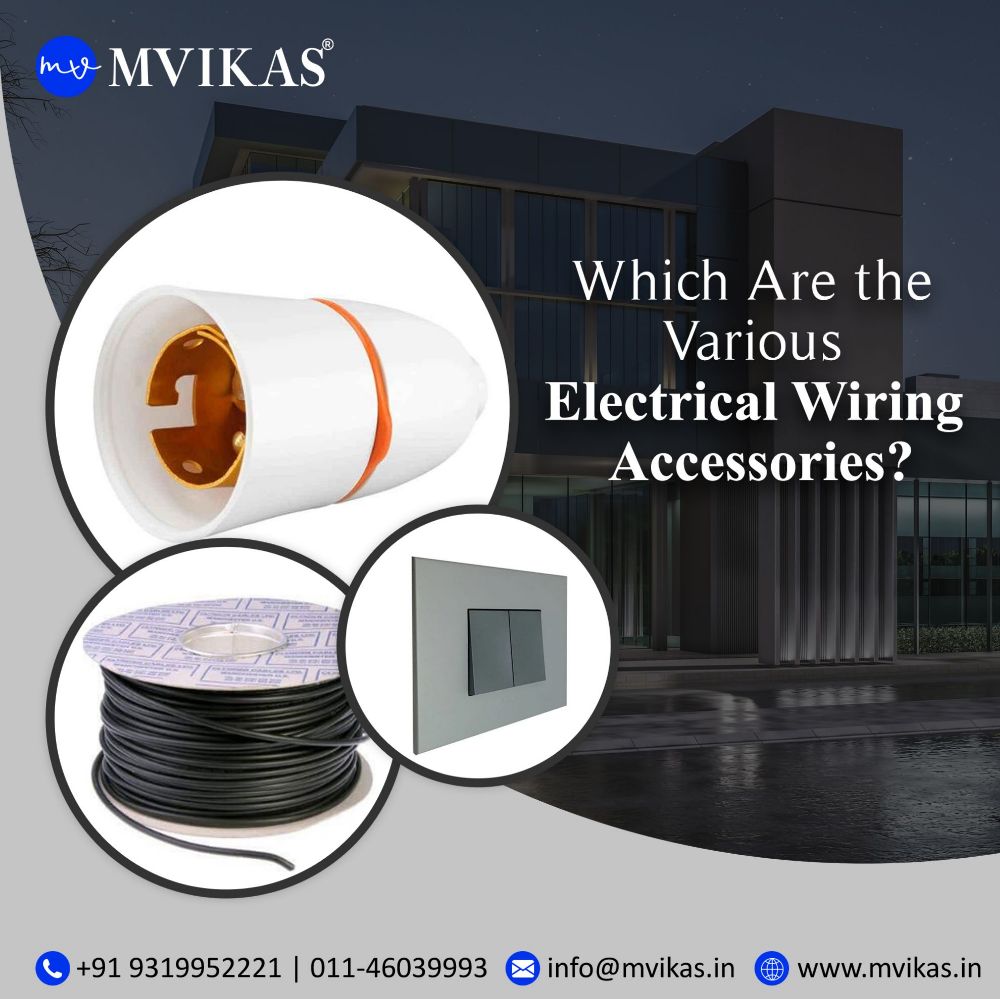Reachable at 9560662883  011-46039993 (Ext. 21 to 32) (10am - 06pm)
011-46039993 (Ext. 21 to 32) (10am - 06pm)
Which Are the Various Electrical Wiring Accessories?

Electrical accessories are devices used in home and industrial electrical wiring, such as switches, holders, sockets, plug-tops, ceiling roses; fuse cut-outs, etc. In reality, newer and more complicated forms of machinery appear in every industry, with a single machine requiring the installation of hundreds of cables!
Let's have a look at some of the various electrical wiring accessories.
- Switch
A switch is a manually controlled device that creates and breaks an electric circuit as needed. The light will continue to burn indefinitely if an electric course is complete. To stop the burning, remove the light from the holder or unplug one of the wires from the generator terminal. Such behaviour is detrimental to the proper operation of a lighting circuit. A switch easily forms and breaks a circuit by pushing a knob or manipulating a handle.
Switches come in various forms; they can have numerous sets of contacts operated by the same knob or actuator, and the connections can work concurrently, sequentially, or alternately. A switch, such as a light switch or a keyboard button, can be operated manually, or it can function as a sensor device, such as a thermostat, to sense a machine part's position, liquid level, pressure, or temperature.
There are several switches, including the toggle switch, rotary switch, mercury switch, push-button switch, reversing switch, relay, and circuit breaker. Lighting control is a popular application, with many switches linked into one circuit to provide simple control of light fixtures. Switches in high-powered circuits prevent destructive arcing when opened.
- Fuses
There are several types of Fuses, to name a few:
- Semi-Conductor Protection Fuse with Trip Indicator-100A
Trip-indicator fuse-links can be used in tandem with main fuse links. They can be connected to the corresponding fuse link or installed individually in panel-mounted fuse clips, Part No. CL1. To provide a remote indication, reference MAI or MBI, a push-on adaptor and micro switch attachment are supplied for use with the trip indicator.
- Solar Fuse Holder
Why should you use a Fuse Holder?
- PHOTOVOLTAIC FUSE: This solar fuse is an excellent way to protect your solar panel, solar controller, and other photovoltaic system components. It will instantly disconnect the circuit if the rated amperage of the fuse is exceeded, preventing harm to the solar equipment.
- EASY INSTALL and STABLE: Plug and play with most solar connections. This solar inline fuse connection can function reliably outside, thanks to the built-in lock on the male connector. This solar fuse connection is UV and age-resistant since it is made of high-quality PPO.
- WATERPROOF: With an IP67 waterproof ring on the male connection, this solar fuse connector will keep you dry on rainy days.
- DEDICATED PV FUSE: This TÜV and CE-certified solar fuse connection is an excellent solution for power surge protection. It is excellent for solar panels, cables, and controllers since it has a solar connection on both ends and a ceramic fuse tube in the middle.
- Lamp Holder
A lamp holder connects the light to the power supply cables. A holder's body is of brass, ebonite, or Bakelite, and it features a molded or porcelain inner socket with a solid or spring plunger and brass terminals. Screws secure the two ends of the connecting wire to these terminals. The holder's top consists of a cap with a central hole connecting the wire to brass terminals. The solid plunger is of a single component.
Because the wiring connections are an inherent component of the plunger, current passes directly through the plunger to the light. The spring plunger is of two parts. The spring is inside a threaded brass barrel. The top cap is secured to the barrel by a threaded brass ring, preventing the porcelain socket from falling out of the holder. The ring is known as a shade carrier. The shade remains squeezed and fastened to the holder between two rings.
A pendant Holder is the holder used to suspend a pendant lamp from a ceiling rose using a flexible wire. When used with a wall bracket, it is a Bracket Holder. Another holder style is directly attached to a wooden batten or ceiling beam. This tube has two wooden pieces known as Cord-Grip, which restrict flexible wire movement within the holder and any stress on the holder connections.
- Electrical Socket
An electrical socket is a device mounted on a wall into which electrical appliances are plugged. The electrical socket is used for both direct and alternate currents. Electrical sockets are typically composed of brass and coated with nickel or tin. Electrical socket materials serve as an interface between the mechanical and electrical systems. Electrical sockets are categorised into fifteen varieties. However, only twelve are commonly used. Electrical sockets are classed differently in different nations.
Electrical sockets are sorted alphabetically, beginning with A to L.


Leave your comment